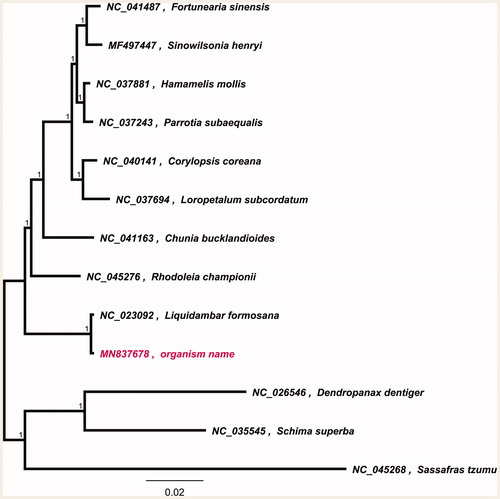Abstract
Semiliquidambar belongs to the family Hamamelidaceae and has comprehensive morphological traits between genus Liquidambar and Mushroom. There are three species of Semiliquidambar, all of which are endemic to China. Semiliquidambar cathayensis is the most widely distributed, from Fujian, Jiangxi to southern Guizhou, southeast and north of Guangxi, Hunan, and Hainan. Semiliquidambar cathayensis belongs to the Vulnerable (UV) in the China Plant Red Data Book. Semiliquidambar has been thought to be a product of natural hybridization but lacks convincing molecular evidence. In this study, the complete chloroplast (cp) genome sequence of an ecospecies S. cathayensis H.T.Chang ‘T5’, which has three leaf morphology, was determined using next-generation sequencing. The entire cp genome was determined to be 160,444 bp in length. It contained large single-copy (LSC) and small single-copy (SSC) regions of 88,969 and 18,913 bp, respectively, which were separated by a pair of 26,281 bp inverted repeat (IR) regions. The genome contained 133 genes, including 88 protein-coding genes, 37 tRNA genes, and eight rRNA genes. The overall GC content of the genome is 37.9%. A phylogenetic tree reconstructed by 13 chloroplast genomes reveals that S. cathayensis is most related with Liquidambar formosana in Hamamelidaceae with bootstrap support values of 100%.
Semiliquidambar belongs to the family Hamamelidaceae and has comprehensive morphological traits between genus Liquidambar and Mushroom (Zhang Citation1979). There are three species of Semiliquidambar, all of which are endemic to China. Semiliquidambar cathayensis is the most widely distributed, from Fujian, Jiangxi to southern Guizhou, southeast and north of Guangxi, Hunan and Hainan. Semiliquidambar cathayensis belongs to the Vulnerable (UV) in the China Plant Red Data Book (Fu Citation1992). Semiliquidambar has been thought to be a product of natural hybridization but lacks convincing molecular evidence. So, it is necessary to develop genomic resources for Semiliquidambar to provide basic intragenic information for further study on phylogeny and bio-conservation in genus Semiliquidambar. An ecospecies S. cathayensis H.T.Chang ‘T5’ which has three leaf morphology (Altingia chinensis, Liquidambar formosana, and hand-shaped leaves) is an ideal sample for hybridization studies because of its comprehensive morphological traits.
The total genomic DNA was extracted from the fresh leaves of S. cathayensis H.T.Chang ‘T5’ (Tiantai Mountain, Nanping city, China, 26.664749 N 117.827477E, altitude 855.5 m) using the DNeasy Plant Mini Kit (Qiagen, Valencia, CA, USA). The voucher specimen was deposited at Herbarium of Fujian Academy of Forestry Sciences (specimen code T5). The whole genome sequencing was conducted by Hefei Biodata Biotechnologies Inc. (Hefei, China) on the Illumina Hiseq 4000 Sequencing System (Illumina, Hayward, CA). The filtered sequences were assembled using the program SPAdes assembler 3.10.0 (Bankevich et al. Citation2012). Annotation was performed using the DOGMA (Wyman et al. Citation2004). All the tRNA sequences were confirmed using the web-based online tool, tRNAScan-SE (Schattner et al. Citation2005) with default settings to corroborate tRNA.
The cp genome of S. cathayensis H.T.Chang ‘T5’ was determined to comprise double stranded, circular DNA of 160,444 bp containing two inverted repeat (IR) regions of 26,281 bp each, separated by large single-copy (LSC), and small single-copy (SSC) regions of 88,969 and 18,913 bp, respectively (NCBI acc. no. MN837678). The genome contained 133 genes, including 88 protein-coding genes, 37 tRNA genes, and eight rRNA genes. The eight protein-coding genes, eight tRNA genes, and four rRNA genes were duplicated in IR region. Nineteen genes contained two exons and four genes (clpP and ycf3 and two rps12) contained three exons. The overall GC content of C. amoena cp genome is 37.9% and the corresponding values in LSC, SSC, and IR regions are 36.1, 32.4, and 43.1%, respectively
To investigate its taxonomic status, whole chloroplast genomes from 10 Hamamelidaceae plants and three outgroup plants (Dendropanax dentiger, Schima sumerba and Sassafras tzumu, ) were aligned using MAFFT version 7 (Katoh and Standley Citation2013). A maximum-likelihood (ML) was reconstructed based on FastTree version 2.1.10 (Price et al. Citation2010). The ML phylogenetic tree shows that C. australis is most related with S. cathayensis H.T.Chang ‘T5’ is most related with Liquidambar formosana in Hamamelidaceae with bootstrap support values of 100%.
Disclosure statement
No potential conflict of interest was reported by the author(s).
Additional information
Funding
References
- Bankevich A, Nurk S, Antipov D, Gurevich AA, Dvorkin M, Kulikov AS, Lesin VM, Nikolenko SI, Pham S, Prjibelski AD, et al. 2012. SPAdes: anew genome assembly algorithm and its applications to single-cell sequencing. J Comput Biol. 19(5):455–477.
- Fu L-K. 1992. China Plant Red Data Book: rare and endangered plants. I. Beijing: Science Press. (In Chinese.)
- Katoh K, Standley DM. 2013. MAFFT multiple sequence alignment software version 7: improvements in performance and usability. Mol Biol Evol. 30(4):772–780.
- Price MN, Dehal PS, Arkin AP. 2010. FastTree 2–approximately maximum-likelihood trees for large alignments. PLoS One. 5(3):e9490.
- Schattner P, Brooks AN, Lowe TM. 2005. The tRNAscan-SE, snoscan and snoGPS web servers for the detection of tRNAs and snoRNAs. Nucleic Acids Res. 33(Web Server issue):W686–W689.
- Wyman SK, Jansen RK, Boore JL. 2004. Automatic annotation of organellar genomes with DOGMA. Bioinformatics. 20(17):3252–3255.
- Zhang H-D. 1979. Flora of China: Vol. 35 Book 2. Beijing (China): Science Press; p. 58.

